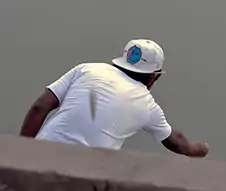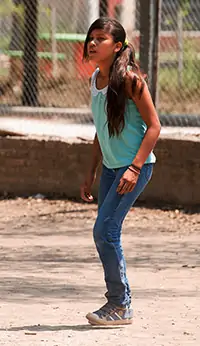The Indigenous Toba People
Ethnonyms: Kom, Komlek, Namgom, Namqom, Qob, Qom, Qom-lik, Qoml'ik Countries inhabited: Argentina, Bolivia, Paraguay Language family: Guaicuruan Language branch: Southern Guaicuruan
Click/tap an image to begin a captioned slideshow and, where available, stock licensing information.

 With the murky Rio Bermejito as his backdrop, this indigenous Toba man fishes for his dinner on an early spring evening. Pulling back, we see the broader context of the river that runs through El Impenetrable in Argentina's Chaco Province.
With the murky Rio Bermejito as his backdrop, this indigenous Toba man fishes for his dinner on an early spring evening. Pulling back, we see the broader context of the river that runs through El Impenetrable in Argentina's Chaco Province.
The area is called El Impenetrable for a reason. It is the western part of El Gran Chaco, the largest area of contiguous dry forest in South America. Its vegetation is so dense that it is, effectively, impenetrable. Except for a few groups of indigenous inhabitants, including the Toba.
 The Spanish arrived here as early as the mid-Sixteenth Century. But their first settlement was abandoned
after 50 years due to intense attacks from the indigenous population.
The Spanish arrived here as early as the mid-Sixteenth Century. But their first settlement was abandoned
after 50 years due to intense attacks from the indigenous population.
 Missionaries followed, but were also met with resistance.
It wasn't until about a hundred years ago that the area began to see large scale immigration from non-indigenous outsiders.
At that time the area was about twice its present size. Logging led to ecological changes in very short order. The cleared land then became the home of a flourishing cotton industry — a source of seasonal wage-labor for the Toba. Living up to its name once again, it wasn't until the 1990s that mechanized harvesting was used on a mass scale. The modernized Toba lost their main source of income.
Missionaries followed, but were also met with resistance.
It wasn't until about a hundred years ago that the area began to see large scale immigration from non-indigenous outsiders.
At that time the area was about twice its present size. Logging led to ecological changes in very short order. The cleared land then became the home of a flourishing cotton industry — a source of seasonal wage-labor for the Toba. Living up to its name once again, it wasn't until the 1990s that mechanized harvesting was used on a mass scale. The modernized Toba lost their main source of income.
 By now many Toba were unable to support themselves. With government encouragement,
By now many Toba were unable to support themselves. With government encouragement,
 around ten thousand relocated to cities further south
— where they continue to live in impoverished conditions.
For those who remained, life became the most difficult it had ever been.
around ten thousand relocated to cities further south
— where they continue to live in impoverished conditions.
For those who remained, life became the most difficult it had ever been.
Traditionally a hunter-gatherer people (and some Toba still are), the ecosystem had now deteriorated to the point that it could not sustain them.
 Then, a new industry swept into the area, soybean cultivation. This has led to further deforestation and pollution, and most of the inhabitants have been forced into the few small (but growing in size) towns that dot the area.
Then, a new industry swept into the area, soybean cultivation. This has led to further deforestation and pollution, and most of the inhabitants have been forced into the few small (but growing in size) towns that dot the area.
 Shortly before I visited Toba communities — and just ahead of a general election in Argentina — a young Toba boy died. While that is not uncommon, the timing was. Óscar Sánchez was 14; at his death he weighed ten kilograms (22 pounds).
While many believe that he died of malnutrition, the government suggested that his death was due to a combination of medical factors.
Shortly before I visited Toba communities — and just ahead of a general election in Argentina — a young Toba boy died. While that is not uncommon, the timing was. Óscar Sánchez was 14; at his death he weighed ten kilograms (22 pounds).
While many believe that he died of malnutrition, the government suggested that his death was due to a combination of medical factors.
 In short, it became political.
In short, it became political.
Beyond daily survival, there isn't a lot to do in Toba communities. Not surprisingly, in a country where Lionel Messi is a national treasure, most boys and young men play football whenever they have free time. Any patch of land large and flat enough becomes a makeshift football pitch. They rarely allow girls to play. So I was surprised as I walked by a school to see this girl playing in an otherwise all-boys' game. I was even more surprised when she continued playing as I started taking photos.
These days many Toba are part of Argentina's National Peasant and Indigenous Movement (Movimiento Nacional Campesino Indígena), which recently took the first steps to see its Declaration of Peasant Rights recognized internationally. Unless organizations like this can succeed in gaining political representation for Argentina's indigenous peoples, the future could be bleak indeed for the remaining Toba.
 With their migration into cities and small towns, along with increasing encroachment by outsiders, the Toba have almost all converted to Christianity. In their churches
they have found a voice through which to express themselves
and their heritage through music;
the now- famous Coro Qom Chelaalapi (Chelaalapi Toba Choir) has been performing indigenous, folkloric music worldwide for over fifty years. Some of their performances can be found on the Internet. The Toba also continue a tradition of basket making and ceramics. Waiting for a bus early one morning to take me into El Impenetrable I observed this Toba woman setting up a small artisan store.
With their migration into cities and small towns, along with increasing encroachment by outsiders, the Toba have almost all converted to Christianity. In their churches
they have found a voice through which to express themselves
and their heritage through music;
the now- famous Coro Qom Chelaalapi (Chelaalapi Toba Choir) has been performing indigenous, folkloric music worldwide for over fifty years. Some of their performances can be found on the Internet. The Toba also continue a tradition of basket making and ceramics. Waiting for a bus early one morning to take me into El Impenetrable I observed this Toba woman setting up a small artisan store.
Photography copyright © 1999 -
2025,
Ray Waddington. All rights reserved.
Text copyright © 1999 -
2025,
The Peoples of the World Foundation. All rights reserved.

Waddington, R., (2016) The Indigenous Toba People. The Peoples of the World Foundation. Retrieved December 18, 2025, from The Peoples of the World Foundation. <https://www.peoplesoftheworld.org/text?people=Toba>
Web Links
El Impenetrable (2012 Documentary/Drama)
Coro Toba Chelaalapi
Aboriginal victims of Argentina's 'silent genocide'
Books
Gordillo, G. R., (2004) Landscapes of Devils: Tensions of Place and Memory in the Argentinian Chaco. Durham, NC: Duke University Press.
Karsten, R .,(1967) The Toba Indians of the Bolivian Gran Chaco. Oosterhout The Netherlands: Anthropological Publications.
Miller, E. S. (Ed.), (1999) Peoples of the Gran Chaco. Westport, CT: Bergin & Garvey.

